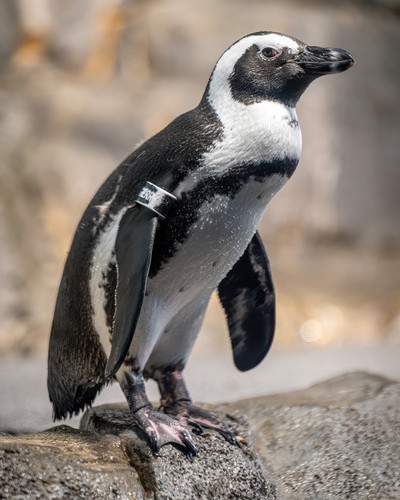- Gerry’s journey to the Maryland Zoo and her role in the conservation efforts for African penguins.
- The significance of the AZA Species Survival Plan in maintaining genetic diversity among captive populations.
- The historical and cultural legacy of Gerry’s namesake, Gerry Low-Sabado, and her contributions to community education.
- The collaborative initiatives between zoos and aquariums to address the breeding and conservation of endangered species.
- The thriving new life for penguins like Monty, and the importance of continued conservation efforts.
Gerry, our vibrant two-year-old African penguin, recently embarked on a significant journey from our aquarium to her new dwelling at the Maryland Zoo. This move is part of a structured effort to conserve critically endangered African penguins and improve their genetic diversity. The collaboration among numerous zoos and aquariums across the United States, facilitated through the AZA Species Survival Plan, represents a cornerstone of these initiatives.
African penguins, native to the southern tip of Africa, face increasing threats in the wild due to habitat loss, oil spills, and declining fish stocks. Conservationists have long been concerned about the dwindling numbers of this species, prompting the implementation of comprehensive breeding programs within controlled environments. Gerry’s move symbolizes this effort: a crucial strategy to prevent the extinction of African penguins and bolster their numbers worldwide. At the Maryland Zoo, Gerry will have opportunities to find a mate, a pivotal step to ensuring healthy genetic lineage within the captive population.
This strategic movement aligns with the AZA Species Survival Plan, a comprehensive program dedicated to the careful management of endangered species. The plan’s primary objective is to foster a genetically diverse population that can sustain long-term survival. By transferring animals like Gerry among accredited institutions, the plan minimizes inbreeding and optimizes the genetic health of the species. It underscores the collaborative spirit necessary among zoo and aquarium communities, which is indispensable for the ongoing success of conservation.
Gerry’s move is emotionally resonant not only due to her role in penguin conservation but also because of her namesake, Gerry Low-Sabado. A respected friend of our institution, Gerry Low-Sabado was instrumental in raising awareness about the Chinese fishing village at Point Alones, a historic site important to our community’s heritage. She championed the acknowledgment and appreciation of the contributions made by Chinese immigrants in the Monterey Bay area. This dedication to local history and cultural education resonates deeply with our mission, and naming our penguin after her honors Low-Sabado’s legacy.
The narrative of departing from one setting to join another isn’t unfamiliar to moving penguins such as Monty, another of our former residents who preceded Gerry to the Maryland Zoo. Monty has since thrived, contributing to a growing line of offspring that bolsters his species’ future. These successful transitions underscore the importance of these inter-institutional exchanges that facilitate breeding opportunities and nurture population health.
Such collaborative efforts are part of a broader wildlife management strategy that encompasses breeding, research, education, and habitat preservation. They require a vast network of shared expertise, resources, and unwavering commitment. The conservation strategies for African penguins and other endangered species are grounded in a scientific approach that balances animal welfare with ecological significance. Zoos and aquariums play a pivotal role in this dynamic, supported by their capacity to educate the public about the importance of biodiversity and ecological stewardship.
The journey of penguins like Gerry and Monty from our aquarium to esteemed institutions such as the Maryland Zoo tells a compelling story. It’s a tale of scientific collaboration and dedication to wildlife conservation. By nurturing genetically diverse populations in captivity, we take crucial steps toward ensuring the longevity and survival of species at risk. This endeavor is a testament to human creativity and commitment, underpinned by generations of scientific research and conservation advocacy.
As we bid farewell to Gerry, we celebrate not only the start of a new chapter in her life but also the overarching goals of conservation efforts orchestrated by organizations dedicated to preserving endangered species. The work continues, and with it, hope is sustained. These structured initiatives illustrate the possibility of renewal and continuity, offering a meaningful contribution to the global endeavor of protecting our planet’s biodiversity. Every move, every handoff among institutions reflects the unwavering belief that together, we can safeguard our natural treasures for future generations.
*****
Source Description
🐧 About a month ago we brayed bon voyage to our two-year-old penguin, Gerry, as she moved to her new home at the Maryland Zoo. Because African penguins like Gerry are critically endangered in the wild, a team of accredited zoos and aquariums across the U.S. works together to maintain a genetically diverse population in their exhibits—a program called the AZA species survival plan. At her new home, Gerry will have the opportunity to choose a mate. (Side note, Monty, who hatched with us and moved to the Maryland Zoo, is thriving and has had a few chicks of his own!)
We wish Gerry all the best, and acknowledge this move is bittersweet. Gerry’s namesake, Gerry Low-Sabado, was a friend of the Aquarium and an important community educator who raised awareness of the Chinese fishing village at Point Alones, right next door to where the Aquarium sits today. Gerry Low-Sabado championed the contributions of Chinese immigrants and their descendants in the Monterey Bay area, and we’re grateful to her and her family for all they have shared with us. 🖤🤍
Want to learn more about Gerry, her namesake, Gerry Low-Sabado, and the AZA Species Survival Plan? Check out the link in our bio to read the full story.


